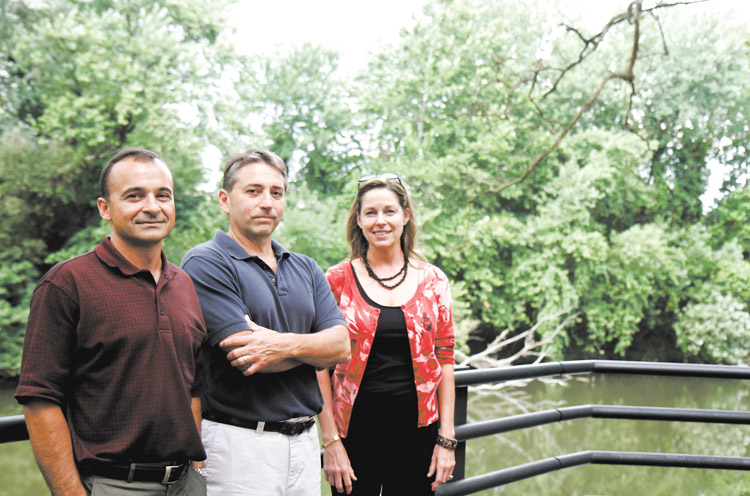River resurgence?


(L-R) Pat Billett, John Kwolek, and Patricia Natalie make up 3 of the 5 Friends of the Mahoning River. They plan to fundraise for the cleaning of the Mahoning River to remove contaminated sediments and make it a more functional area. They are seen behind the B & O restaurant which has a direct view of the river in Youngstown, Ohio.
By Elise Franco
Youngstown
While many look at the Mahoning River and see a hopeless reminder of what it once was, the Friends of the Mahoning River see opportunity.
The group, which has about 50 active members, has a long-term goal of completely cleaning the contaminated sediment and removing six of the river’s eight dams.
John Kwolek, of Canfield, said most of the dams were built during the steel boom to cool water near the factories and no longer serve a purpose. He said Friends of the Mahoning River is in the process of applying for nonprofit status, which would allow it to apply for state grants that are needed to begin the cleanup process.
“Each cleanup and dam removal will cost about $5 million,” he said. “The process is time-consuming and very competitive.”
The river’s sediment is so contaminated that Kwolek said it’s currently under a dermal contact advisory, which means that the sediment in portions of the river could cause a skin reaction.
“One of our goals is to get that lifted,” he said. “We owe it to the river to clean it up.”
Kwolek said removing the dams and contaminated sediment will help restore free-flow to the river, which will allow wildlife and recreation to re-emerge.
“It will create a free-flowing system where fish can migrate back and forth,” he said. “Economically, a clean river will be a benefit to any area. Once you do the cleanup, you get the recreation back.”
Patricia Natali, of Youngstown, said the group also focuses on educating the public about the importance of its cause.
Natali said the group meets monthly and is planning a RiverFest event on Oct. 6 at the B&O Station on Mahoning Avenue in Youngstown.
“People have this attitude of, ‘Who cares? It’s the Mahoning River,’” Natali said. “Getting the river back in shape would bring an appreciation back to the city and jumpstart economic development.” Kwolek said Valley residents’ attitudes toward the Mahoning need to change.
“The Mahoning River has been excommunicated,” he said. “We have a generation of people here who have never made the river a part of their lives. No other place is like that, but here, nobody gives it a second thought.”
Kwolek noted that other Ohio cities, such as Columbus, Cleveland, Kent and Cuyahoga Falls, have successfully obtained grant money, cleaned their rivers and incorporated them into their way of life.
“A clean river can mean fishing, canoeing, kayaking, biking, river walks. These are all activities we would like to see here,” he said.
Group members admit that they have lofty ambitions and a long way to go, however.
Ed Wilk of Lordstown said he knows the cleanup effort will take time, and its success largely depends on the availability of grant funding. Wilk said even if the group achieves its cleanup goal, the work will continue.
“Once the river is clean it will be an unrestricted effort in bringing back the habitat,” he said. “And the cultural effort will never end.”
 43
43
